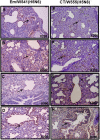Comparison of the pathogenic potential of highly pathogenic avian influenza (HPAI) H5N6, and H5N8 viruses isolated in South Korea during the 2016-2017 winter season
- PMID: 29535296
- PMCID: PMC5849756
- DOI: 10.1038/s41426-018-0029-x
Comparison of the pathogenic potential of highly pathogenic avian influenza (HPAI) H5N6, and H5N8 viruses isolated in South Korea during the 2016-2017 winter season
Abstract
Highly pathogenic avian influenza (HPAI) A(H5N6) and A(H5N8) virus infections resulted in the culling of more than 37 million poultry in the Republic of Korea during the 2016/17 winter season. Here we characterize two representative viruses, A/Environment/Korea/W541/2016 [Em/W541(H5N6)] and A/Common Teal/Korea/W555/2017 [CT/W555(H5N8)], and evaluate their zoonotic potential in various animal models. Both Em/W541(H5N6) and CT /W555(H5N8) are novel reassortants derived from various gene pools of wild bird viruses present in migratory waterfowl arising from eastern China. Despite strong preferential binding to avian virus-type receptors, the viruses were able to grow in human respiratory tract tissues. Em/W541(H5N6) was found to be highly pathogenic in both chickens and ducks, while CT/W555(H5N8) caused lethal infections in chickens but did not induce remarkable clinical illness in ducks. In mice, both viruses appeared to be moderately pathogenic and displayed limited tissue tropism relative to HPAI H5N1 viruses. Em/W541(H5N6) replicated to moderate levels in the upper respiratory tract of ferrets and was detected in the lungs, brain, spleen, liver, and colon. Unexpectedly, two of three ferrets in direct contact with Em/W541(H5N6)-infected animals shed virus and seroconverted at 14 dpi. CT/W555(H5N8) was less pathogenic than the H5N6 virus in ferrets and no transmission was detected. Given the co-circulation of different, phenotypically distinct, subtypes of HPAI H5Nx viruses for the first time in South Korea, detailed virologic investigations are imperative given the capacity of these viruses to evolve and cause human infections.
Conflict of interest statement
The authors declare no conflict of interest.
Figures





Similar articles
-
Pathogenicity and genetic characterisation of a novel reassortant, highly pathogenic avian influenza (HPAI) H5N6 virus isolated in Korea, 2017.Euro Surveill. 2018 Feb;23(7):18-00045. doi: 10.2807/1560-7917.ES.2018.23.7.18-00045. Euro Surveill. 2018. PMID: 29463346 Free PMC article.
-
Experimental infection of highly pathogenic avian influenza viruses, Clade 2.3.4.4 H5N6 and H5N8, in Mandarin ducks from South Korea.Transbound Emerg Dis. 2018 Jun;65(3):899-903. doi: 10.1111/tbed.12790. Epub 2017 Dec 20. Transbound Emerg Dis. 2018. PMID: 29266850
-
Genetic diversity of highly pathogenic avian influenza H5N6 and H5N8 viruses in poultry markets in Guangdong, China, 2020-2022.J Virol. 2025 Jan 31;99(1):e0114524. doi: 10.1128/jvi.01145-24. Epub 2024 Dec 4. J Virol. 2025. PMID: 39629997 Free PMC article.
-
The genetics of highly pathogenic avian influenza viruses of subtype H5 in Germany, 2006-2020.Transbound Emerg Dis. 2021 May;68(3):1136-1150. doi: 10.1111/tbed.13843. Epub 2020 Sep 29. Transbound Emerg Dis. 2021. PMID: 32964686 Review.
-
Epidemiology and pathobiology of H5Nx highly pathogenic avian influenza in South Korea (2003-2024): a comprehensive review.Vet Q. 2025 Dec;45(1):23-38. doi: 10.1080/01652176.2025.2498918. Epub 2025 May 7. Vet Q. 2025. PMID: 40332021 Free PMC article. Review.
Cited by
-
Characterization of highly pathogenic avian influenza H5Nx viruses in the ferret model.Sci Rep. 2020 Jul 29;10(1):12700. doi: 10.1038/s41598-020-69535-5. Sci Rep. 2020. PMID: 32728042 Free PMC article.
-
Genetic diversity, phylogeography, and evolutionary dynamics of highly pathogenic avian influenza A (H5N6) viruses.Virus Evol. 2020 Nov 21;6(2):veaa079. doi: 10.1093/ve/veaa079. eCollection 2020 Jul. Virus Evol. 2020. PMID: 33324491 Free PMC article.
-
Co-existence and co-infection of influenza A viruses and coronaviruses: Public health challenges.Innovation (Camb). 2022 Sep 13;3(5):100306. doi: 10.1016/j.xinn.2022.100306. Epub 2022 Aug 17. Innovation (Camb). 2022. PMID: 35992368 Free PMC article. Review.
-
Modulation of lethal HPAIV H5N8 clade 2.3.4.4B infection in AIV pre-exposed mallards.Emerg Microbes Infect. 2020 Jan 23;9(1):180-193. doi: 10.1080/22221751.2020.1713706. eCollection 2020. Emerg Microbes Infect. 2020. PMID: 31969057 Free PMC article.
-
Pandemic potential of highly pathogenic avian influenza clade 2.3.4.4 A(H5) viruses.Rev Med Virol. 2020 May;30(3):e2099. doi: 10.1002/rmv.2099. Epub 2020 Mar 5. Rev Med Virol. 2020. PMID: 32135031 Free PMC article. Review.
References
-
- Bouwstra R, Koch G, Heutink R, et al. Phylogenetic analysis of highly pathogenic avian influenza A (H5N8) virus outbreak strains provides evidence for four separate introductions and one between-poultry farm transmission in the Netherlands, November 2014. Eur. Surveill. 2015;20:21174. doi: 10.2807/1560-7917.ES2015.20.26.21174. - DOI - PubMed
Publication types
MeSH terms
Grants and funding
LinkOut - more resources
Full Text Sources
Other Literature Sources
Medical
